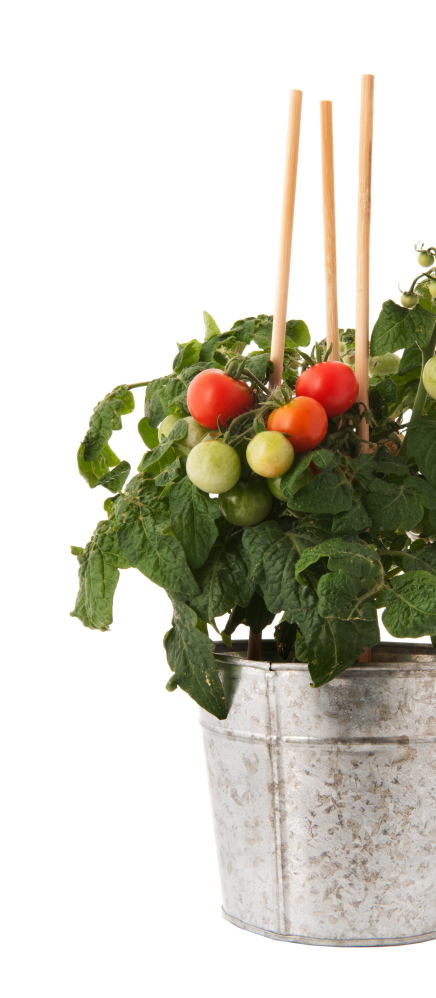It’s Memorial Day weekend, time to get serious about vegetable gardening. If you don’t own a plot of land, no worries. Just plant in containers.
Even if you have a garden plot, growing certain vegetables in pots has its advantages. Last summer was awful for tomatoes. We waited until September for the first full-size slicing tomatoes. But a pot of tomatoes we had on the patio produced good-sized tomatoes in early August. The secret? The pot was above the ground, sitting on a sunny brick patio where the soil warmed up more quickly, allowing for faster production.
You can use almost any kind of container to grow vegetables. If you have plastic pots left over from buying container-grown shrubs or trees, use those. Wooden crates will work for a couple of years before rotting. Some garden centers sell bags specifically for growing vegetables; they’re made from the same plastic material used for tarps. You can also use actual flower pots or convert 5-gallon pails into containers by putting holes in the bottom.
Whichever you chose, bigger is better. Soil dries out more quickly in pots than it does in the garden, and it does so especially fast in smaller pots. In addition, the roots need some room.
The type of soil you use is important for container gardening. Standard container mix is lightweight and good at retaining moisture; it works nicely for container planting, but for one thing – it doesn’t have a lot of nutrients. To address the lack, add a slow-release fertilizer compost when you first plant your containers. Don’t use soil straight from the garden, which will be too heavy and dense for pots – if it gets dry, it will resemble a brick. To lighten its texture for containers, mix garden soil with planting mix and compost: Take your wheelbarrow, put in several shovels of garden soil, followed by several of mix and then stir in composted cow manure (find the last at garden centers or some hardware stores).
Your container-grown vegetables will need a lot of watering – almost daily in the heat of summer. We have two rain barrels on the patio near most of our containers, and I water nightly as the grill heats up for dinner. But having lot of water-holding organic matter in the soil will keep the plants healthy if you go away for a weekend.
What should you grow? To begin, go with compact plants. In a garden, indeterminate tomatoes make sense because these plants keep getting larger, and the tomatoes ripen throughout the season. For a container, though, you need a bush-type determinate tomato, which will stand up with a little support, and not get too big. Keep in mind that determinate tomatoes will all ripen at about the same time.
Also, my wife, Nancy, is interested in the aesthetics of the pots, so we often do vegetables that look as good as they taste. Bright Lights Swiss chard, which comes in a variety of colors, is a colorful and gorgeous plant, so we always have that in a pot. Similarly, lettuces grow well in pots and come in many attractive shades. Abide by the old container gardening rule – combine “thriller, filler and spiller.” What does this mean in practice for vegetables? In each container, plant something like a yellow pear-shaped tomato (the thriller), surround it with leaf lettuces (the filler) and then plant nasturtiums on the side to spill over the container edge (the spiller, it goes without saying).
Peppers also look good in pots. The leaves are shiny, and the fruits glisten as they ripen from green to orange and then red. We once grew purple peppers – a great “thriller” for the center of a pot. The peppers will need some support or the wind may blow them down. Plants in the onion family grow well in pots, whether regular onions, chives or green onions – a nice filler. I think you could even do leeks, but I’ve never tried.
For the past few years, we’ve grown potatoes in bags that are designed to grow potatoes. The bags are about 30 inches high, and you plant the potatoes in about 6 inches of soil and keep covering the plants with soil until you reach the top of the bag. We’ve produced about 5 pounds of potatoes from each bag. I tried tomatoes in a square bag one year but the bags collapsed on the side. The round bags work better, for potatoes or other plants.
Some beans would work well in containers, but use bush beans rather than pole beans. For best looks, plant beans of multiple colors. You can mix vegetables, of course, and you can mix various edibles in large pots: grow tomatoes with basil as the filler or put cilantro in the middle of the pots with cherry tomatoes spilling over the edge.
Let your mind run wild – and think about what you want to eat come August.
Tom Atwell has been writing the Maine Gardener column since 2004. He is a freelance writer gardening in Cape Elizabeth. Contact him at 767-2297 or at:
tomatwell@me.com.
Send questions/comments to the editors.



Success. Please wait for the page to reload. If the page does not reload within 5 seconds, please refresh the page.
Enter your email and password to access comments.
Hi, to comment on stories you must . This profile is in addition to your subscription and website login.
Already have a commenting profile? .
Invalid username/password.
Please check your email to confirm and complete your registration.
Only subscribers are eligible to post comments. Please subscribe or login first for digital access. Here’s why.
Use the form below to reset your password. When you've submitted your account email, we will send an email with a reset code.